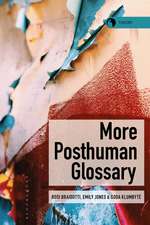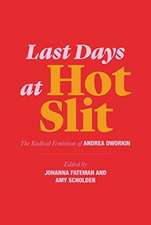Queer Phenomenology – Orientations, Objects, Others
Autor Sara Ahmeden Limba Engleză Paperback – 3 dec 2006
Preț: 196.55 lei
Nou
Puncte Express: 295
Preț estimativ în valută:
37.61€ • 40.84$ • 31.60£
37.61€ • 40.84$ • 31.60£
Carte tipărită la comandă
Livrare economică 22 aprilie-06 mai
Preluare comenzi: 021 569.72.76
Specificații
ISBN-13: 9780822339144
ISBN-10: 0822339145
Pagini: 240
Dimensiuni: 152 x 229 x 13 mm
Greutate: 0.35 kg
Editura: MD – Duke University Press
Locul publicării:United States
ISBN-10: 0822339145
Pagini: 240
Dimensiuni: 152 x 229 x 13 mm
Greutate: 0.35 kg
Editura: MD – Duke University Press
Locul publicării:United States
Recenzii
[G]round shaking. The book is disorienting in a good way. It invites the reader to be shaken, disoriented, to question our selves and our position and it evokes the power and necessity of disorientation as a source of movement and challenge. Ahmed doesnt seem to insist that we deny the positions we currently occupy, or to move on, but to reorient ourselves. Like earthly tremors, queer phenomenology facilitates the formation of lines and fissures along the spaces of our existence, as events that open up new connections, rather than points in lines that bind us to existing structures and spaces in which living obliquely is made uncomfortable, if not impossible.Margaret Mayhew, Cultural Studies Review
Ahmeds most valuable contribution in Queer Phenomenology is her reorienting of the language of queer theory. The phenomenological understanding of orientation and its attendant geometric metaphors usefully reframes queer discourse, showing disorientation as a moment not of desperation but of radical possibility, of getting it twisted in a productive and revolutionary way.Zachary Lamm, GLQ
This is an original and refreshing use of phenomenological theory to address the kinds of questions--about orientations and about how bodies and objects become oriented through their interrelations--that help link it more directly to political and social questions--about gender, sexuality, and race, for example--that have tended to be treated as outside or beyond phenomenological frameworks. This extension and development of phenomenology is a major contribution.--Elizabeth Grosz, author of The Nick of Time: Politics, Evolution, and the Untimely
In this dazzling new book, Sara Ahmed has begun a much needed dialogue between queer studies and phenomenology. Focusing on the directionality, spatiality, and inclination of desires in time and space, Ahmed explains the straightness of heterosexuality and the digressions made by those queer desires that incline away from the norm, and, in her chapter on racialization, she puts the orient back into orientation. Ahmeds book has no telos, no moral purpose for queer life, but what it brings to the table instead is an original and inspiring meditation on the necessarily disorienting, disconcerting, and disjointed experience of queerness.--Judith Halberstam, author of In a Queer Time and Place: Transgender Bodies, Subcultural Lives
Finally, a theorist who takes sexual orientation at its word. In this moving meditation on directionality, Sara Ahmed takes phenomenology for a turn through queer theory, postcolonial studies, feminism, critical race theory, geometry, and labor politics. In the world Ahmed encourages us to reinhabit, as bodies come to matter, bodily action materializes space, children inherit proximities rather than attributes, privileged bodies sink into familiarity, and politics is at its best when it involves a measure of disorientation. Follow her lines of reasoning and youll never again reach for an explanation, a book, or a lover without wondering how your grasp extended so far in the first place.--Kath Weston, author of Gender in Real Time: Power and Transience in a Visual Age
"[G]round shaking. The book is disorienting in a good way. It invites the reader to be shaken, disoriented, to question our selves and our position and it evokes the power and necessity of disorientation as a source of movement and challenge. Ahmed doesn't seem to insist that we deny the positions we currently occupy, or to move on, but to reorient ourselves. Like earthly tremors, queer phenomenology facilitates the formation of lines and fissures along the spaces of our existence, as events that open up new connections, rather than points in lines that bind us to existing structures and spaces in which living obliquely is made uncomfortable, if not impossible." - Margaret Mayhew, Cultural Studies Review "Ahmed's most valuable contribution in Queer Phenomenology is her reorienting of the language of queer theory. The phenomenological understanding of orientation and its attendant geometric metaphors usefully reframes queer discourse, showing disorientation as a moment not of desperation but of radical possibility, of getting it twisted in a productive and revolutionary way." - Zachary Lamm, GLQ "This is an original and refreshing use of phenomenological theory to address the kinds of questions--about orientations and about how bodies and objects become oriented through their interrelations--that help link it more directly to political and social questions--about gender, sexuality, and race, for example--that have tended to be treated as outside or beyond phenomenological frameworks. This extension and development of phenomenology is a major contribution."--Elizabeth Grosz, author of The Nick of Time: Politics, Evolution, and the Untimely "In this dazzling new book, Sara Ahmed has begun a much needed dialogue between queer studies and phenomenology. Focusing on the directionality, spatiality, and inclination of desires in time and space, Ahmed explains the straightness of heterosexuality and the digressions made by those queer desires that incline away from the norm, and, in her chapter on racialization, she puts the orient back into orientation. Ahmed's book has no telos, no moral purpose for queer life, but what it brings to the table instead is an original and inspiring meditation on the necessarily disorienting, disconcerting, and disjointed experience of queerness."--Judith Halberstam, author of In a Queer Time and Place: Transgender Bodies, Subcultural Lives "Finally, a theorist who takes sexual 'orientation' at its word. In this moving meditation on directionality, Sara Ahmed takes phenomenology for a turn through queer theory, postcolonial studies, feminism, critical race theory, geometry, and labor politics. In the world Ahmed encourages us to reinhabit, as bodies come to matter, bodily action materializes space, children inherit proximities rather than attributes, privileged bodies sink into familiarity, and politics is at its best when it involves a measure of disorientation. Follow her 'lines' of reasoning and you'll never again reach for an explanation, a book, or a lover without wondering how your grasp extended so far in the first place."--Kath Weston, author of Gender in Real Time: Power and Transience in a Visual Age
Ahmeds most valuable contribution in Queer Phenomenology is her reorienting of the language of queer theory. The phenomenological understanding of orientation and its attendant geometric metaphors usefully reframes queer discourse, showing disorientation as a moment not of desperation but of radical possibility, of getting it twisted in a productive and revolutionary way.Zachary Lamm, GLQ
This is an original and refreshing use of phenomenological theory to address the kinds of questions--about orientations and about how bodies and objects become oriented through their interrelations--that help link it more directly to political and social questions--about gender, sexuality, and race, for example--that have tended to be treated as outside or beyond phenomenological frameworks. This extension and development of phenomenology is a major contribution.--Elizabeth Grosz, author of The Nick of Time: Politics, Evolution, and the Untimely
In this dazzling new book, Sara Ahmed has begun a much needed dialogue between queer studies and phenomenology. Focusing on the directionality, spatiality, and inclination of desires in time and space, Ahmed explains the straightness of heterosexuality and the digressions made by those queer desires that incline away from the norm, and, in her chapter on racialization, she puts the orient back into orientation. Ahmeds book has no telos, no moral purpose for queer life, but what it brings to the table instead is an original and inspiring meditation on the necessarily disorienting, disconcerting, and disjointed experience of queerness.--Judith Halberstam, author of In a Queer Time and Place: Transgender Bodies, Subcultural Lives
Finally, a theorist who takes sexual orientation at its word. In this moving meditation on directionality, Sara Ahmed takes phenomenology for a turn through queer theory, postcolonial studies, feminism, critical race theory, geometry, and labor politics. In the world Ahmed encourages us to reinhabit, as bodies come to matter, bodily action materializes space, children inherit proximities rather than attributes, privileged bodies sink into familiarity, and politics is at its best when it involves a measure of disorientation. Follow her lines of reasoning and youll never again reach for an explanation, a book, or a lover without wondering how your grasp extended so far in the first place.--Kath Weston, author of Gender in Real Time: Power and Transience in a Visual Age
"[G]round shaking. The book is disorienting in a good way. It invites the reader to be shaken, disoriented, to question our selves and our position and it evokes the power and necessity of disorientation as a source of movement and challenge. Ahmed doesn't seem to insist that we deny the positions we currently occupy, or to move on, but to reorient ourselves. Like earthly tremors, queer phenomenology facilitates the formation of lines and fissures along the spaces of our existence, as events that open up new connections, rather than points in lines that bind us to existing structures and spaces in which living obliquely is made uncomfortable, if not impossible." - Margaret Mayhew, Cultural Studies Review "Ahmed's most valuable contribution in Queer Phenomenology is her reorienting of the language of queer theory. The phenomenological understanding of orientation and its attendant geometric metaphors usefully reframes queer discourse, showing disorientation as a moment not of desperation but of radical possibility, of getting it twisted in a productive and revolutionary way." - Zachary Lamm, GLQ "This is an original and refreshing use of phenomenological theory to address the kinds of questions--about orientations and about how bodies and objects become oriented through their interrelations--that help link it more directly to political and social questions--about gender, sexuality, and race, for example--that have tended to be treated as outside or beyond phenomenological frameworks. This extension and development of phenomenology is a major contribution."--Elizabeth Grosz, author of The Nick of Time: Politics, Evolution, and the Untimely "In this dazzling new book, Sara Ahmed has begun a much needed dialogue between queer studies and phenomenology. Focusing on the directionality, spatiality, and inclination of desires in time and space, Ahmed explains the straightness of heterosexuality and the digressions made by those queer desires that incline away from the norm, and, in her chapter on racialization, she puts the orient back into orientation. Ahmed's book has no telos, no moral purpose for queer life, but what it brings to the table instead is an original and inspiring meditation on the necessarily disorienting, disconcerting, and disjointed experience of queerness."--Judith Halberstam, author of In a Queer Time and Place: Transgender Bodies, Subcultural Lives "Finally, a theorist who takes sexual 'orientation' at its word. In this moving meditation on directionality, Sara Ahmed takes phenomenology for a turn through queer theory, postcolonial studies, feminism, critical race theory, geometry, and labor politics. In the world Ahmed encourages us to reinhabit, as bodies come to matter, bodily action materializes space, children inherit proximities rather than attributes, privileged bodies sink into familiarity, and politics is at its best when it involves a measure of disorientation. Follow her 'lines' of reasoning and you'll never again reach for an explanation, a book, or a lover without wondering how your grasp extended so far in the first place."--Kath Weston, author of Gender in Real Time: Power and Transience in a Visual Age
Notă biografică
Textul de pe ultima copertă
"This is an original and refreshing use of phenomenological theory to address the kinds of questions--about orientations and about how bodies and objects become oriented through their interrelations--that help link it more directly to political and social questions--about gender, sexuality, and race, for example--that have tended to be treated as outside or beyond phenomenological frameworks. This extension and development of phenomenology is a major contribution."--Elizabeth Grosz, author of "The Nick of Time: Politics, Evolution, and the Untimely"
Descriere
Theoretical study of the spatialization of sexuality through a consideration of how the "orientation" of bodies within a social space informs concepts of sexual desire.




























